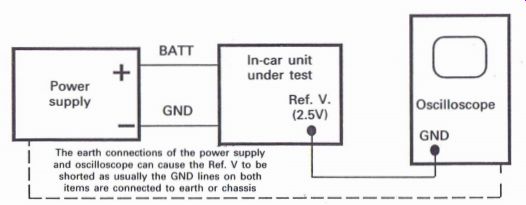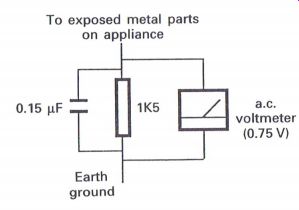The various aspects of health and safety have made apparent the many hazards within the working environment where service engineers are involved.
There are areas which must be considered to ensure that the health, safety and even livelihood of employee, employer and also the customer must be considered at all times.
Service manuals cover many factors within the servicing of most domestic products, and a wide range of reference books are available on this subject. A brief selection is listed at the end of this appendix; these together with many more are usually available from public libraries.
Ideally all workshop facilities should include essential items such as isolating transformers, and also some form of residual current circuit breaker (RCCB) system. Unfortunately neither of these items will be available to the engineer when confronted with servicing products in the customer home. Also, some of these items have to be serviced in the most inappropriate positions (field service engineers have many an interesting tale to tell in this respect).
This subject area can only be briefly covered in this appendix and will relate generally to servicing CD players as it may be assumed that most workshop environments may already include acceptable facilities for servicing other types of domestic product.
The main area of concern when servicing CD players is the area concerning laser radiation, and players usually contain labels that relate to relevant cautions and the class of the laser product (see Fig. 6.6).
As previously mentioned in the sections concerning
Adjustments and Fault Diagnosis ( Sections 6 and 9), care should be taken concerning exposure to the laser, especially when the cabinet top cover has been removed, and the optical assembly is operated in a manner that can enable the laser beam to be viewed.
There is in existence a publication that specifically refers to laser products titled:
Radiation safety of laser products, equipment classification, requirements and user's guide.
Publication 825 First edition 1984.
International Eletro-technical Commission--IEC Standard.
This is a Swiss publication, which is printed in English and French. It is useful to be aware of pages 41 and 43 in particular; relevant extracts are as follows:
The eart h connections of the power supply and oscilloscope can cause the Ref . V to be shorted as usually the GND lines on both items are connected to eart h or chassis

Figure A2.1
Health and safely 9.2 Definition of laser classes.
Laser products are grouped into four general classes for each of which accessible emission limits (AELs) are specified. Class 1 lasers are those that are inherently safe (so that the maximum permissible exposure level cannot be exceeded under any condition) or are safe by virtue of the engineering design.
Author's note: Class 1 lasers are used within CD and laserdisc players. They are in effect the lowest power level and are frequently adjusted to levels in the region of 0.12 to 0.23 mW. However, information is available from a publication referred to as BS 4803 pt 3 with certain amendments made in 1984 which provides calculations which refer to the Maximum Permissible Laser Emission (MPE) of Class 1 lasers as being 0.625 mW, which in fact is the maximum acceptable from these lasers under fault conditions, as well as the maximum adjustable condition.
Class 3B lasers may emit visible and/or invisible radiation . . . CW lasers may not exceed 0.5 W.
Note: Direct intrabeam viewing near these devices is always hazardous.
Viewing unfocused pulsed laser radiation by diffuse reflection is not hazardous and under certain conditions CW laser beams may be safely viewed via a diffuse reflector.
These conditions are:
a. a minimum viewing distance of 13 cm.
b. a maximum viewing time of 10 secs.
Author's note: In view of the conditions mentioned above with respect to a CW laser of 0.5 W, where CW means that it is permanently on such as in CD players when playing the disc. the recommended viewing distance mentioned in Section 6 is 50 cm, extreme safety being applied if it is considered necessary to view a Class 1 laser.
Regarding the maximum viewing time of 10s, how long does a person have to look at any type of lamp to determine whether it is on or not? It is unlikely that 10s is required.
As previously mentioned, the author never recommends anyone to view the laser beam of a CD player, but that is a decision for the person involved.
It is hoped that the foregoing regarding lasers in CD players may create confidence in their non-lethality, and like many things in life, excess is not good for the individual and therefore sensible precautions must apply.
Whenever a new type of optical assembly is introduced in a CD player, the laser incorporated in that new type is always tested to extremely strict conditions by BEAB to ensure that the required safety standards are maintained.
Equipment safety
The major reference regarding most safety aspects related to mains-operated electronic and related equipment for household and similar general use is the BS1 publication BS415, and the Health and Safety Executive have issued an information sheet that relates to portable electrical equipment and refers to the Electricity at Work Regulations of 1989, where one of the regulations, 4(2), states:
As may be necessary to prevent danger, all systems shall be maintained so as to prevent, so far as is reasonably practicable, such danger.
The word 'system' as defined in the Regulations includes portable electrical equipment, and the effect of this is to require duty holders to maintain the portable electrical equipment in a safe condition. Typical of portable electrical equipment in the workshop is the oscilloscope and regular checks should be carried out to maintain such items in a safe condition. The reason for mentioning the oscilloscope in particular is that it is the item of equipment that is frequently operated with the earth connection removed, particularly for servicing television receivers.
However, on some models of in-car CD players it frequently occurs that a reference potential, to which the common connection of the oscilloscope may be connected during adjustment procedures, can be shorted to ground or chassis via the chassis and earth connection circuit that can be developed between the oscilloscope and the power supply, as illustrated in Fig. A2.1.
Figure A2.2 Earth ground, etc

Leakage current checks Some service manuals also give details of leakage
tests on mains-powered electrical equipment, and there generally three
recommended methods.
1. Usually for USA models, i.e. 120 V supply.
Measure the leakage current to a known earth by connecting a leakage current tester between the earth ground and all exposed metal parts of the appliance (input/output terminals, screwheads, metal overlays, control shafts, etc.). Plug the appliance directly into a 120 V a.c. 60 Hz outlet, and turn the ac. power switch on. Any current measure must not exceed 0.5 mA. Any measurements not within these limits are indicative of a potential shock hazard and must be corrected before returning the appliance to the customer.
2. (This information is available in Sony service manuals.) The a.c. leakage from any exposed metal part to earth ground and from all exposed metal parts to an exposed metal part having a return to chassis must not exceed 0.5 mA. The leakage current can be measured by any one of three methods:
(i) A commercial leakage tester, such as the Simpson 229 or RCA WT-SOA. Follow the manufacturers' instructions to use these instruments.
(ii) A battery-operated a.c. milliammeter. The Data Precision 245 digital multimeter is suitable.
(iii) Measuring the voltage drop across a resistor by means of VOM or battery operated a.c. voltmeter.
The 'limit' indication is 0.75 V, so analog meters must have an accurate low voltage scale. The Simpson 250 and Sanwa SH~63 Trd are examples of passive VOM that is suitable. Nearly all battery-operated digital multimeters that have a 2 V a.c. range are suitable (see Fig. A22).
3. A high voltage insulation tester is another method to be recommended, and is a specialized unit which supplies an output in the region of 1.5-2.0 kV which should be connected between either of the mains connections and any exposed metal parts, and the test carried out for l min.
During this period of testing no current in excess of 2 mA or 700 uA a.c. should flow.
Product safety notices
Most service manuals emphasize the importance of replacing defective components with the manufacturer's recommended replacement, especially where those components are specifically identified in the service manual as having specialized safety characteristics.
Improperly performed repairs can adversely affect not only the safety of a product, but also its reliability, and may void the warranty or service contract if undertaken by an unauthorized servicing agent.
Furthermore, whilst productivity figures are a major requirement in many service operations, safety must be the main criterion when servicing any form of electrical appliance, and if an accident occurs which results in death, ?re, injury or other form of physical damage as a result of an inferior repair, especially the replacement of a safety Component with a non-recommended type or non-safety type, the relevant engineer who serviced the product can be held responsible, and will therefore be liable to prosecution as well as responsible for the costs of the resulting loss.
Manufacturers ensure at the design stage that their appliances comply with the relevant recommendations of the specific safety standard B8415, which enables BEAB approval to be obtained.
Therefore it is irresponsible for an appliance to be serviced in a manner that infringes any of the safety codes which manufacturers have been encouraged over the years to provide, and which ensure that products are manufactured to the highest safety requirements.
Solder and related toxicity
It is interesting to note that some service manuals occasionally contain a reference to the lead content in solder and the fumes that are produced by the process of soldering. Generally the service manuals that usually contain such information relate to products intended for the American market, but the information may well be of general interest to engineers and an example is as follows:
WARNING: Lead in solder used in this product is listed by the California Health and Welfare agency as a known reproductive toxicant which may cause birth defects or other reproductive
Health and safety harm (California Health and Safety Code, Section 25249.5). When servicing or handling circuit boards and other components which contain lead in solder, avoid unprotected skin contact with the solder. Also, when soldering do not inhale any smoke or fumes produced.
Some recommended publications available regarding health and safety B8415 ~ British Standards Institute.
Usually available in the reference section of public libraries and also from BSI Sales, Linford Wood, Milton Keynes MK14 6LE.
Maintenance of Portable Electrical Equipment--HSE Information Sheet.
HSE Information Centre, Broad Lane, Sheffield S3 7HQ. Tel. (0742) 892345.
Broadhurst, A. (1990) Health and Safety. Pitman, London.
A NatWest Business Handbook, which provides a range of extremely useful information on general health and safety recommendations.
------------------